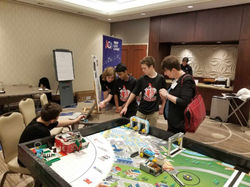
Known as The Walking Lead, we are a team of grade 7 and 8 students from Glen Ames Public School in Toronto ON. This year our team received the challenge to invent a solution surrounding the human water cycle as many world wide issues surrounding the health of civilians and animals revert back to the water we ingest.
What problem is our team trying to solve?
This year our team had many project ideas for the hydrodynamics season! On the day we set to finalize our seasons project idea, the story linked below hit the Toronto Star Paper: https://www.thestar.com/news/canada/2017/10/06/more-than-640-ontario-schools-and-daycares-fail-lead-tests-in-the-past-two-years.html
After reading the article, curiosity arose amongst members of the team each wondering if our school was listed as one of the schools whom had failed the provincial lead test. Sure enough, it was one of the failing schools and we were somewhat shocked as it was apparent that no members of the school community including students, staff, and administration seemed to have knowledge of this issue! To further our knowledge, we thought it would be interesting to take our own water sample to see how much lead was in our school's water system. Our initial test of pre-flushed water showed 29 parts per billion of lead (ppb is used to measure the concentration of a contaminant in sediments)! We learned that the acceptable lead level for the province of Ontario is 10ppb, but scientists actually recommend 0-1ppb. Scientists also claim that there are no safe levels of lead to consume as it accumulates in an individual's body over time!
To build a foundation for our project we researched about the health effects of consuming lead and further discovered that it mostly affects children. With 640 schools and daycares failing the lead test in Ontario, we instantly knew this was an issue we needed to tackle. Lead affects the brain, liver and kidney. It has been proven to cause behaviour and learning problems as increased lead levels directly correlate with IQ scores. The world-famous Water Brothers came by the school to speak with our team and helped reinforce the importance of this issue by mentioning, “You are what you eat, but even more what you drink”. This quote validated that the topic of lead contamination in drinking water was an underlining issue of importance.
What is the solution and how does the solution work?
In order to produce a valid solution, we wanted to ensure we fully understood the problem we were tackling. We started to interview experts from various fields to get a variety of knowledge surrounding the human water cycle, lead contamination and political statistics. We began with our school caretaker who told us that flushing the taps was something done every morning at 6AM. He informed us that flushing was the recommended way to keep lead levels low and our research supported this as well. Concerned that he only had time to run the taps for a short amount of time because of how many locations he had to get too, it seemed like a very time-consuming job. This is when we first wondered if there might be a better way to flush the schools taps and reduce the amount of work done by caretakers.
The single most important quote in coming up with our invention came from Bruce Lamphear (Professor, Faculty of Health Sciences Simon Fraser University) when he said;
“Even if you flush it and it goes down it can build up within about 30 minutes back up to the pre-flushed levels and we can’t expect the maintenance guys at the schools to walk around and flush these things before every class break”
At this point we knew there was a major problem. If flushing is done at 6AM, and it only takes 30 minutes for lead levels to return to the original pre-flushed levels, the current solution of human flushing is not efficient nor effective! We knew there must be a better way to resolve this issue and that’s when we turned to robotics to help develop a conclusive, systematic solution!
The next step in our process was to discover how the problem could be solved. Obviously replacing the pipes to newer pipes is the ideal solution but is also the most expensive. Filters are another option but, also very expensive over time. Flushing was the one cost effective solution for a school board that already has a backlog of repairs and debt. It also allows a faster implementation process as no labor-intensive work would be necessary.
What if there was a machine that could auto-flush every 30 minutes? This was the question our team had in mind and from this, the idea for our solution “The Royal Flush” was born. We discovered that there are already auto-flushers that are very expensive and need to be built into the plumbing, so we kept our focus on how to keep our product inexpensive and easy to install. We wanted a device that could be screwed onto a tap, and we wanted the device to ideally cost less than $100. We knew we had our work cut out for us!
With no pluming experts on our team, we turned to our roots of utilizing Lego components and EV3 software programming! We needed a way for the taps to turn on automatically so, we partnered with another product called “The EZ Faucet”. The EZ faucet has a motion sensor that triggers the valve and runs the water. We attached an EV3 brick to the back side of this component and added a large motor with an arm to trigger the motion sensor. We then developed an algorithm that allowed The Royal Flush to run the taps for five minutes in the morning in order to remove any lead components present in the water. While discussing our product with experts, we discovered that the longer you let the taps run, the colder the water gets until it reaches the minimum temperature that it can be on a given day. The colder the water, the less lead present. This line is somewhat confusing. Maybe incorporate the points that the longer you let the taps run, the lower the temperature gets and the lower the temperature, the less lead present. With five minutes being long enough to reach the minimum temperature, we then recorded this temperature as a variable. After every 30 minutes, The Royal Flush would kick in and flush just long enough for the temperature of the water to reach the minimum value recorded. Often times it would only take a minute or two. This was important as we wanted to waste the least amount of water as possible while keeping the water lead free.
It was time to find out if our product worked. With the royal flush installed, we sent off royally flushed water samples to Toronto Water, run by the city of Toronto and waited in suspense for the results. When they came back we were delighted to discover that the lead levels had dropped from 29ppb to 0.167ppb, over a 99% reduction in the quantity of lead!
But how many of these would we need to keep the entire school lead free? For this we needed to go to City Hall to find our school blueprints. From those, we tracked down the most likely “end of lines”. If a Royal Flush was installed at each end of line, this would also flush all of the fixtures on the existing plumbing line. Ultimately five or six royal flushes would keep approximately 1000 students consuming lead free water on a daily basis!
How would the solution be implemented?
With the Lego version of The Royal Flush working well, we still had one obstacle. $500 per line was still a bit expensive as each school would likely need several products. We wondered if there was a way to reduce our costs by 80%. The answer was Arduino! We were not experts in Arduino or C++, so after coming 2nd place in our provincial competition we devoted all of our time to learning the Arduino environment. We came up with a prototype in time for the Ontario Innovation Celebration that did indeed allow us to showcase a version that was approximately $100.
Recently, we also started a partnership with the tech company Slalom (inventors of the Starbucks app), who are willing to work with our team to make the product even smaller and cheaper! They’ve suggested a way to get rid of the Arduino breadboard (replacing it with a shield) and the EZ faucet (replacing it with a valve). We will be working with them regularly to produce The Royal Flush 4.0!
Once the 4.0 is ready to go, we would approach the TDSB with a product that for less than $100 could keep entire lines of plumbing lead free. Schools would need to let us know how many lines of plumbing they have and purchase a Royal Flush for each line. Normally, this would be 4-6 devices. To put our product into perspective, for roughly $500 a school would be able to keep their school’s water lead free and reduce the health risks open to their students! Since royally flushing also wastes less water than manually flushing, schools would save more than $500 in their first year! When you think of it that way, the product pays for itself in one year! (Not to mention the time it saves the teachers and caretakers who no longer need to flush!)
Our dream is to go global with this invention! Any buildings that are from the 1970s or earlier likely have the same problems we do. There is a mass market of potential to help millions of students from all around the world. Anyone can install the device and all schools can justify the cost, not only because of the health benefits, but because of the cost savings. The future deserves it! Let’s Royally Flush away the lead problem worldwide!
Achievements
Our product, known as the Royal Flush was entered in the FIRST LEGO League (FLL) competition this year which welcomed innovations for this year’s theme, Hydro Dynamics. The competition challenged students to research a world problem and develop a solution. Team members learned to think like scientists and engineers, develop critical thinking and team-building skills, basic presentation abilities and STEM applications – science, technology, engineering and math.
In January our team finished second at the Eastern Ontario Championships and won the Champions Award at the Ontario Innovation Celebration in February. These achievements qualified our team to continue to FIRST LEGO League’s LEGOLAND Open Championship Tournament in California this May as well as the Global Innovation Celebration this June in San Jose California. Here, we will be competing against the worlds top 20 teams at a chance to win $20,000 and further implement our product.
Thank you for reading about our team and the accomplishes we have made. For any inquiries please feel free to contact us below.
“Don't let the lead, get to you head!” - The Walking Lead
Student X Engineer
ABOUT US
 |  |
|---|---|
 |  |
 |  |
 |  |
 |  |
 Initial Idea |  Royal Flush 2.0 |
|---|---|
 Royal Flush 3.0 |  Royal Flush 4.0 |
 Royal Flush 4.0 |  Royal Flush 4.0 |
 Royal Flush 4.0 |